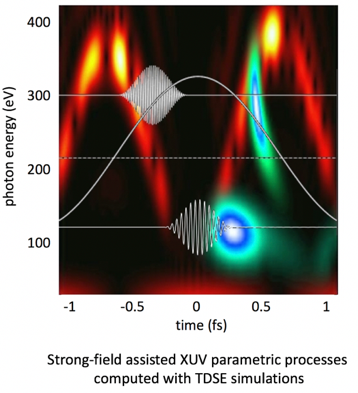Attosecond Nonlinear Optics and X-ray Lasers

Coherent up-conversion of near-infrared femtosecond laser light into the extreme ultraviolet and soft-x-ray regions of the spectrum using the process of high-harmonic generation allows to extend concepts from nonlinear optics well into the x-ray region. Coherent x-rays represent one of the most powerful tools for understanding molecules and materials at the nanoscale, uncovering important information related to magnetism, photochemistry, materials, biology, nanoscience and many other areas of science and technology. In biology and medicine, ultrafast coherent x-ray sources promise to capture the most basic processes, such as charge transfer, photosynthesis or cell death, on their fundamental timescales. "Extreme" nonlinear optics opens the door to develop new methods for quantum coherent control in the weak and moderate intensity regimes, combined to more intense-field processes, for bridging the gap between femtochemistry, attosecond physics and attochemistry. To date, research in coherent x-ray science has predominantly been carried out using synchrotron large scale facilities. We investigate new ultrafast x-ray coherent light amplifiers that promise to complement and substitute in many cases the need of large scale synchrotron facilities. This represents a truly great challenge for x-rays spectroscopy science and for the attophysics scientific community.
Involved Researchers: C. Serrat, J. L. Font.
Associated projects
Perspectives for hard X-ray selective cancellation of the effect of target molecules in pathogens. X-ray absorption spectroscopy may provide a unique absorption spectrum that can serve as a fingerprint of the state of a particular atom or molecule. It has been reported that exposure to laser-produced X-rays pulses with relatively high peak intensities does not lead to increased harm to mammalian cells exposed in vitro compared with the harm induced from exposure to X-rays with the same dose from conventional medical sources, concluding that the use of high-power laser facilities for medical imaging is justified [1]. We are studying both through numerical simulations and experimentally the capability of the four-wave mixing (FWM) effect described in [2] at relatively low laser peak pulse intensities in biomolecules maybe also combined with biomolecules labellings. Initially the optimal biomolecules targets and possible labeled molecules have to be identified and characterized with precision from their X-ray absorption spectra. As first tests, we are considering some molecular model synthesized zinc complexes that have recently been characterized [3], to later study more realistic metalloproteins active centers and other molecules. We hence expect to be able to efficiently produce nonlinear FWM processes locally and selectively in some biologically relevant molecules using ultrashort hard X-ray FEL pulses with medical harmless doses.

Attosecond nonlinear optics and X-ray lasers. In this project, we investigate the coherent dynamics of electron wavepackets inside atoms and molecules and the amplification of attosecond pulses and lasers in the x-ray region of the electromagnetic spectrum. In close cooperation with the experiments, we study high-harmonic generation processes and strong-field assisted attosecond transient absorption spectroscopy, which are essential for applications in faster optical detectors and electronics, and in imaging and coherent control in biology and medicine. Additionally, we study selective quantum control of population transfer and vibrational coherences in the ground and excited state of atoms and molecules by shaped femtosecond multi-pulses, for quantum entanglement via Rydberg excitation and as a first step towards using its combination with engineered attosecond pulses in a full attochemistry control scenario.
Scientific coordinator: C. Serrat.
Funding Agency: Ministerio de Economía y Competitividad.
Participants: C. Serrat, J. L. Font.
Project ref. No.: FIS2017-85526-R.
Start/Ends dates: 01/01/2018 - 31/12/2021.

Share: